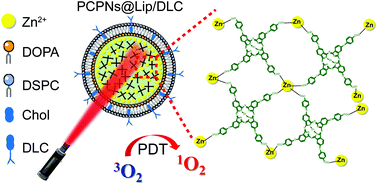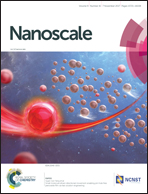Phthalocyanine-based coordination polymer nanoparticles for enhanced photodynamic therapy†
Abstract
In the photodynamic therapy (PDT) of cancer, zinc phthalocyanine (ZnPc) as a photosensitizer possesses superior photosensitive properties. However, the therapeutic effect of ZnPc in PDT is limited due to its aggregation, low solubility and poor selectivity. In this study, charge-reversal phthalocyanine-based coordination polymer nanoparticles (PCPN) are developed for improving the curative effect of ZnPc. Tetra(4-carboxyphenoxy)-phthalocyaninatozinc(II) (TPZnPc) is coordinated with the zinc ion to form the core of PCPN, which is coated with a lipid bilayer by self-assembly (PCPNs@Lip). TPZnPc molecules in the core of PCPN are in the monomeric state and can generate cytotoxic singlet oxygen (1O2) efficiently, which solves the solubility and aggregation problems of ZnPc. Meanwhile, 1,2-dicarboxylic-cyclohexane anhydride modified lysyl-cholesterol (DLC) is functionalized on the surface of PCPN (PCPNs@Lip/DLC), endowing PCPN with a charge-reversal ability which could be triggered by a mildly acidic tumor microenvironment. PCPNs@Lip/DLC is proved to enhance tumor cellular uptake and generate more intracellular 1O2 after irradiation. As confirmed by in vitro and in vivo studies, PCPNs@Lip/DLC remarkably increases the PDT effect. All these results demonstrate that PCPNs@Lip/DLC is a promising nanoplatform for the application of ZnPc in effective PDT.



 Please wait while we load your content...
Please wait while we load your content...